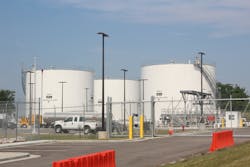2022 Airport Business Project of the Year: A New Pipeline Fuels the Future of St. Louis

Burns & McDonnell aided St. Louis Lambert International Airport (STL) in doubling capacity of its bulk jet fuel storage.
The company completed the 3 million-gallon bulk jet fuel storage facility in April. The $50 million project includes three above-ground fuel tanks, each able to store up to 1 million gallons of jet fuel. It also includes space for a fourth tank if STL has increased demand.
“You’re going to see better reliability,” said Kurt Janisch, project manager for Burns & McDonnell. “The efficiency and reliability are going to improve. The power supply is going to benefit from the variable frequency drive, so now can throttle the supply and fuel to the airport.”
The airport’s initial fuel storage and hydrant system was constructed in 1957 and the fuel tanks were underground. The pump pressure was also too high as they were designed during the heyday of TWA at STL. They had to modify the pumps and Janisch said every time they did, they would find more problems with the system.
Burns & McDonnell started addressing issues with the old fuel storage system in 2013. The fuel consortium at STL started discussing a replacement of the system one year later.
“The old fuel storage facility had limited room to expand capacity and instead of investing further in an antiquated underground storage tank system, the fuel consortium decided it was prudent to invest in a new fuel storage facility with above-ground storage tanks,” said Ruvim Katan, chairman of the STL Fuel Committee.
All the fuel storage at the airport was in 41 underground storage tanks, which Janisch said creates an environmental issue because there’s no visibility to see potential leaks or degradation of the storage system.
In 2015, the Environmental Protection Agency (EPA) changed its regulations and decided to no longer exclude airport hydrant systems from underground storage tank rules. That meant additional operator training, providing leak detection on all 41 tanks.
“The biggest driver was initially leaks from the hydrant system that ended up in the stormwater creek that goes off of the airport,” Janisch said. “The other driver was reliability. We were having problems with the pumps failing.”
The tanks were constructed on an 8-acre greenfield site at STL, which includes a 4,300-square-foot operations building with a control room, vehicle maintenance shop and offices.
Burns & McDonnell will demolish and remove everything from the old fuel storage facility. STL will be able to utilize the area for a different purpose for the future.
Jerry Beckmann airport deputy director, planning and development for STL, said the airport is currently undergoing a layout plan update and the old site will likely result in parking usage.
“The existing fuel farm site is 3 acres next to parking near the terminal,” he said. “The big plus of this is that it’s freeing up that space for development engaged in revenue generation.”
Janisch said planners looked at several sites on the STL property, which had contaminated soil. The chosen location for the new fuel storage facility is in a former subdivision that was removed due to noise abatement issues.
The site is also across the street from one of the two fuel supply pipelines, making an easy connection.
“Being an old subdivision, we recognized there would be no environmental aspects to the construction activities,” Janisch said. “We would not be digging through impacted material and then having to deal with that.”
The chosen site is farther from the closest connection to the terminal, so Burns & McDonnell had to build a 2-mile long pipeline to connect the new fuel storage facility to the hydrant system. The pipeline wraps around the eastern side of the airport and through the airline cargo operations area to the hydrant system at Terminal 2.
The 11,000-foot underground fuel transmission pipeline with a leak detection system delivers fuel to the terminal, along with five horizontal pumps, each capable of delivering fuel at 1,200 gallons per minute.
Janisch said the pipeline route had to work around any of the potential airport improvements STL is considering as to not impede future construction.
“The biggest challenge was thinking through what is needed, how are we going to construct it and how are we going to future-proof this system so that it doesn’t become a problem for the airport or St. Louis County or the city of Berkeley,” Janisch said.
Work on the project took about two years to complete. Janisch said the project didn’t speed up the construction timeline, but it did allow for some efficiencies and less nighttime work.
“Fortunately, this took place in the summer of 2020 when air traffic was significantly down,” Beckmann said. “Had we had to do this during normal summer traffic, it would’ve been much more unpleasant.”
They were able to run the pipeline through a parking lot primarily used by Southwest Airlines employees due in part to fewer flights. Janisch said this allowed them to avoid an originally planned route through an alley, which had more utilities than initially anticipated.
STL invested another $50 million into other fueling-related infrastructure as part of the project, including hydrant system improvements, a new emergency fuel shut-off system, a hydrant cart test facility, a truck load facility and parking, and new fueling stations for ground service equipment.
“The GSE fueling was driven by the airport. Fuel was delivered at the gate to each individual piece of GSE equipment,” Janisch said. “STL recognized that create more opportunities for fuel spills. As part of this project, they wanted individual GSE gas stations.”
Beckmann said upgrading approximately 20-30 hydrant locations ensured attachment points were in perfect condition to connect with the transfer line.
“There were a lot of projects that occurred in front of and concurrent to the fuel farm upgrades,” he said.
The new fuel storage facility became fully operational in August. Katan said the reduction in operational complexity, increased protection from environmental risk and ability for airlines to store additional fuel inventory to mitigate supply risk have already greatly benefited the airlines.
“The new fuel storage facility helps improve operations at STL by providing a new environmentally friendly, state-of-the-art fuel system and more fuel storage capacity to support future growth in air travel for decades to come,” he said.
- Location: St. Louis, Missouri
- Project: STL Fuel Farm
- Cost: $50 million
- Completion: February 2021
- Key Participants: St. Louis International Airport, Burns & McDonnell, STL Fuel Committee
About the Author
Joe Petrie
Editor & Chief
Joe Petrie is the Editorial Director for the Endeavor Aviation Group.
Joe has spent the past 20 years writing about the most cutting-edge topics related to transportation and policy in a variety of sectors with an emphasis on transportation issues for the past 15 years.
Contact: Joe Petrie
Editor & Chief | Airport Business
+1-920-568-8399
>> To download the AviationPros media kits, visit: Marketing Resource Center
>>Check out our aviation magazines: Ground Support Worldwide | Airport Business | Aircraft Maintenance Technology
